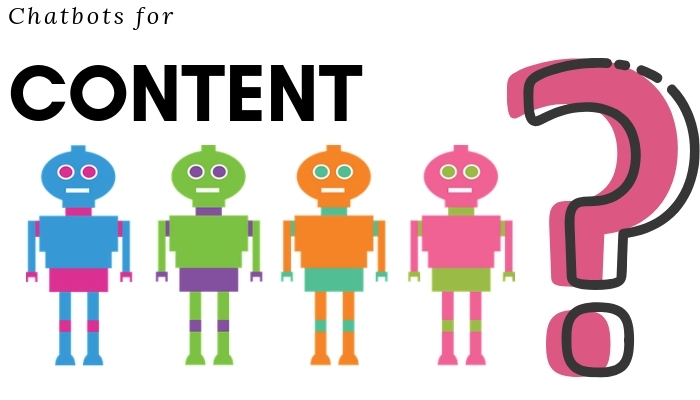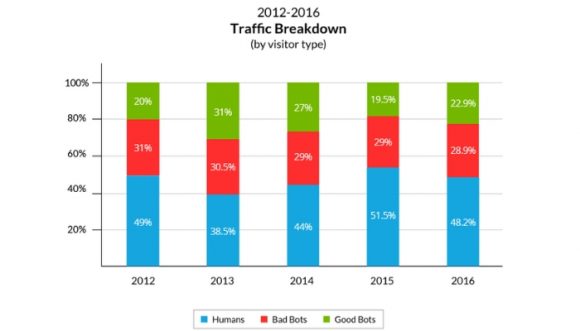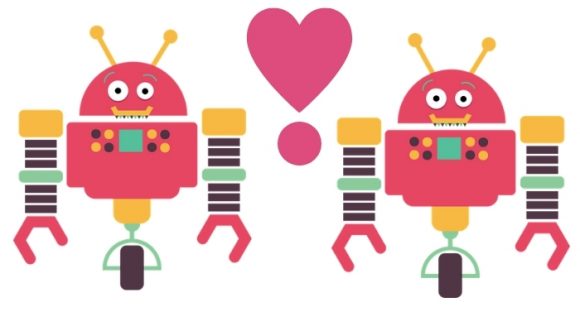Should You Blend AI Chatbots into Your Content Marketing Strategy in 2019?

What Do We Mean Exactly When We Say AI Chatbot?
A bot is a computer program that simulates communication with a person in a conversational interface. These are of two basic types: those that use Automated Help (AH), like automated phone systems, and those that use Artificial Intelligence (AI), which we’ll focus on in this article.
Thanks to the immense progress in artificial intelligence and mobile, marketers can use chatbots as a powerful and effective tool for enhanced user interaction. In fact, according to research in 2016 by Imperva Incapsula, bots were responsible for generating more than fifty percent of internet traffic, as demonstrated in the graph below.

These new-generation AI chatbots can constantly learn how to respond to complex queries and personalize responses to improve interactions over time. These bots use special protocols that recognize not only text but voice as well.
What makes these bots so appealing to marketers is their ability to be programmed by setting rules on a “bot-building” platform, often without needing any prior knowledge of how to write a single line of code.
Why You Should Make Chatbots Part of Your Content Marketing Strategy

A strong statistical case for AI chatbots
Chatbots are a great way to engage users, and the proof that users are more than just warming up to them is in the numbers. Check out these statistics on chatbot usage and their ability to drive purchases online, as discovered by chatbot providers Ubisend:
|
Chatbot Statistics |
||
|
Consumer sentiment |
Business profitability |
Chatbot industry landscape |
|
27% of consumers say that they would buy a basic item with the assistance of a chatbot. (Drift, 2018) |
47% of consumers are happy to buy items from a chatbot. (HubSpot, 2017) |
96% of businesses say chatbots are here for the long haul. (Mindbrowser, 2017) |
|
48% of consumers prefer connecting to a company through live chat than any other means of contact. (HubSpot, 2017) |
Chatbots are capable of saving companies up to £6 billion per year across industries. (Juniper Research, 2017) |
$4.5 billion will be invested in enterprise-intelligent assistants by 2021. (Opus Research, 2017) |
|
35% of consumers would like to see more companies make use of chatbots. (Ubisend, 2017) |
28% of top-performing businesses use AI for marketing. (Adobe, 2018) |
Between 2016 and 2021, chatbot marketing will grow at a compound rate of 35.2%. (Marketsandmarkets, 2017) |
Bots are dethroning apps
Chatbots are the new sweethearts of online user engagement, particularly when it comes to mobile interactions. These days, no one wants to download a dozen apps that end up clogging their phone, when one messenger app is capable of integrating with AI chatbots.
Today, chatbots can integrate into applications that a user already has, such as Facebook Messenger, WhatsApp, and SnapChat. If a customer wants to order a pizza or needs to know if she should carry an umbrella when she goes to work, she can do that from an app that she uses regularly and trusts. There is no need for her to enter the marketplace to download multiple apps, set up accounts and fidget with passwords.
By removing all these barriers, chatbots makes life easier for the user, are more appealing, and are less likely to turn users away who don’t want to jump through hoops just to resolve their query. The secret to achieving success with a chatbot is providing real value in the places where your audience already spends their time. What a buyer really wants is the most direct line from their pain point to the best solution.
Personalised content and increased engagement
Chatbots help marketers take general content and provide it to the people who need it most. This creates the illusion that you’re understanding users’ individual needs and personalizing content for them to provide value. This, in turn, improves the quality of engagement between the brand and the user, which is crucial to cultivate loyalty and push users through the sales funnel. A typical user who interacts with a bot is in search of a specific solution and wants to get quick answers.
You can use bots to filter and choose from your existing content to provide the user with the exact content that will satisfy their core need. Just as providing value should be at the heart of your content creation strategy, it should also inform your content distribution strategy.
Let’s say a user needs to buy a new printer — they could visit your website, scroll through several product pages to find one that meets their requirements, and then go through the checkout process. But if your website has a bot, the user can simply tell it what they need and be guided to the most relevant option. The bot simply matches intent with the right content to satisfy the user’s needs, reducing the likelihood of a customer being unhappy with their purchase because they didn’t do their research.
How to Blend AI Chatbots into Your Content Marketing Strategy

Many businesses are still indecisive when it comes to AI chatbots, but others are on the opposite side of the spectrum — they rush into implementing AI chatbots haphazardly without considering how it will blend into their overall content strategy.
Go back to the content marketing basics
To successfully implement a chatbot into your content marketing strategy, you need to go back to the core of your content strategy — your buyer personas. If done properly, these should clearly outline the buyer’s journey and give you a list of questions your target audience is likely to have. The key is to dig deep and consider “what-if?” scenarios — remember that there is no such thing as a stupid question.
With a solid content strategy in place, you should find that the majority of your answers come from existing content. Leave no stone unturned and analyze the queries users of your site search for, as well as speak to your customer service team. This is a goldmine of frequently asked questions and customer concerns. If you can resolve the majority of queries via your chatbot, you free up resources and make sure that only urgent and complex queries get pushed through to a real person.
Decide which approach to take
Once you’ve done your research and gathered your most useful content, it’s time to sit down with your team and set your priorities. Why? Just because you have existing content that covers several topics does not mean that your chatbot needs to have all of it readily available in its interface. Be selective when you consider what to feed your bot and what to leave out — a chatbot that focuses on high-priority tasks and executes them perfectly is more appreciated by and useful to the end user than a jack of all trades that can only partially resolve a query.
You must also determine your approach towards queries that your chatbot may not be able to answer or does not understand. You’ll often see chatbots asking additional questions for clarification or begin to go round in circles when they don’t understand the intent behind a user’s question. This is a fatal sin when the end goal is a conversion or increased trust, because nothing turns off a potential buyer more than a lack of clarity.
Marketing Insider Group reports that more than half of US shoppers canceled a planned purchase because of a bad customer service experience. Your chatbot may be exactly that — a bot — but you need to consider it an extension of your customer service efforts and understand that users speaking to a bot online have the same frustrations as those speaking to a rep on the phone or walking into a bricks-and-mortar store. Extensive delays or an inability for the bot to do what it’s programmed to will not just lead a user to leave the conversation — they may decide not to follow up via phone or email and instead go somewhere else entirely.
Your chatbot is a goldmine of data, so you should use it accordingly. Take advantage of the opportunity to polish your content destined for the chatbot interface to constantly increase the value you provide. With chatbots able to collect user information such as geolocation, age, name, gender, session duration, and previously asked questions, you can use this data not just to create new content, but also to personalize conversations with and emails to subscribers by considering their queries. It may all be automated, but it will go a long way to building a relationship with your customer base.
Get your chatbot
When it comes to implementing your chatbot, you have two choices: hire a developer to build one from scratch, or set one up yourself. Getting a bot built for you may seem like the safer option, but it’s often unnecessary, especially for small businesses on a budget. It might seem intimidating to set up a bot yourself — especially as there’s potential for it to go wrong — but the majority of platforms are intuitive and come with excellent support to guide you through the process. As is the key with any new integration, it’s important you test it extensively before rolling it out to prevent any embarrassments and mishaps.
Some bots, such as ChatClub, for example, are specific to a certain platform — in this case, Messenger. Before choosing your bot platform, research your options and make sure you select one that integrates with your chosen interface.
ABOUT THE AUTHOR
Alwi Suleiman has a decade’s worth of digital marketing experience. He has helped many companies in different industries achieve their online marketing goals. He currently works at Exposure Ninja as a content marketing specialist.

